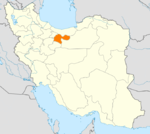- National Museum of Iran
-
 The building itself was designed by French architect Andre Godard in the early 20th century. He also helped design the main campus of Tehran University.
The building itself was designed by French architect Andre Godard in the early 20th century. He also helped design the main campus of Tehran University.
The National Museum of Iran (in Persian: موزه ملی ايران Mūze-ye Millī-ye Irān) is a museum in Tehran, Iran. It is the combination of two museums, the old Muze-ye Irân-e Bâstân (Archaeological Museum of Iran, a break, Sasanian revival building and inaugurated in 1937), and the modernistic white travertine National Arts Museum ("Mūze-i Honar-i Millī"), inaugurated in 1972. The second structure, built on the grassy grounds of the old Archaeological Museum, went through quite a few, and hasty changes of the interior, and was still being remodeled when the Islamic Revolution swept the country in 1978.
While the old museum always had a clear mandate to show archaeological relics (to also include some rare medieval textiles and rug pieces), the new museum began its life by featuring the exquisite Amlash pottery from the prehistoric Caspian Sea regions of Iran. This was followed by some modern arts, and the numerous gutting and remodeling of the interior. It was only after the Islamic Revolution than the new building was appended to the old, to form the "National Museum of Iran." The two buildings are dedicated respectively to the pre-Islamic collection (the old break building), while the new, travertine building contains post-Islamic artifacts. Together, they preserves ancient and medieval Persian antiquities including pottery vessels, metal objects, textiles, books, coins etc.
Building One consists of three halls. The three halls contain artifacts from the lower, middle, and upper Paleolithic, as well as the Neolithic, Chalcolithic, early and late Bronze Age, and Iron Ages I-III, through the Median, Achaemenid, Seleucid, Parthian, and Sassanid periods.
The post-Islamic part of the museum was inaugurated in 1996 and consists of three floors. It contains various pieces of pottery, textiles, texts, artworks, astrolabes, and adobe calligraphy from Iran's 1,400-year Islamic history.
The original museum (Building One) was designed by Andre Godard, a French architect. It is located in central Tehran.
Plans are underway for the construction of a new building, as the current one lacks the capacity and standards for preserving all of Iran's excavated treasures. There are a number of research departments in the museum, including the Paleolithic Department, Center for Achaemenid Research, and Center for Ceramic Studies.
Collections
The oldest artefact in the museum are from Kashafrud, Darband and Ganj Par, sites that date back to the Lower Paleolithic period. Mousterian stone tools made by Neanderthals are also on display in the first hall. The most important Upper Paleolithic tools are from the Yafteh Cave, dating back approximately 30,000-35,000 years. There are also 9,000 year old human and animal figurines from Teppe Sarab in Kermanshah Province among the many other ancient artifacts.
See also
- Safir Office Machines Museum
- Iranian Crown Jewels
- Tehran Museum of Contemporary Art (website)
- Iran's National Rug Gallery
- Talar Vahdat Theater
- Darabad Museum of Natural History
- Iran Cultural Heritage Organization
- Azarbaijan Museum
- International rankings of Iran
- Malek National Library
- Surena
- Reza Abbasi Museum
External links
- National Museum of Iran
- Sa'd Abad Gallery of Fine Arts
- Glassware Museum of Tehran
- Hamid-Reza Hosseini, Shush at the foot of Louvre (Shush dar dāman-e Louvre), in Persian, Jadid Online, 10 March 2009, [1].
Audio slideshow: [2] (6 min 31 sec).
Coordinates: 35°41′13.36″N 51°24′52.60″E / 35.6870444°N 51.414611°E
 Tehran Province
Tehran ProvinceCapital 
Counties and Cities Baharestan CountyMalard · SafadashtPakdasht · SharifabadPishva CountyQods CountyQodsRey* · Baqershahr · Hasanabad · KahrizakRobat Karim CountyLandmarks Azadi Tower · Bahman Cultural Center · Carpet Museum of Iran · Dizin · Ebn-e Babooyeh · Golestan Palace · Grand Bazaar, Tehran · Iranian Crown Jewels · Malik National Museum of Iran · Milad Tower · Naderi Throne · National Museum of Iran · Niavaran Palace Complex · Peacock Throne · Pearl Palace · Sa'dabad Palace · Saltman · Samarian spinel · Shahr-e Bazi · Shebeli Tower · Shemshak · Bibi Shahr Banu Shrine · Tangeh Savashi · Tehran Museum of Contemporary Art · Tughrul Tower · Toopkhaneh · Reza Abbasi Museum- indicates that this formerly independent city is now absorbed into Tehran.
Categories:- Museums established in 1937
- Museums in Tehran
- 1937 architecture
- National museums of Iran
- Iranian architecture
Wikimedia Foundation. 2010.



